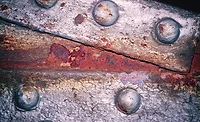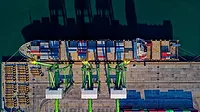Novel Corrosion Inhibitors
for High-Performance Coatings
According to a study initiated by NACE International that illustrates the broad and expensive challenge that corrosion presents, total annual corrosion costs in the United States rose above $1 trillion in the middle of 2013. At an estimate of over 6.2% of GDP, corrosion is one of the largest single expenses in the U.S. economy. Corrosion carries a very high price tag for the United States, only exceeded by health care.1 A 2001 U.S. government-sponsored study estimated the costs of corrosion for military systems and infrastructure alone to be about $20 billion annually.2 Most of the loss is due to the corrosion of iron and steel used in the fabrication of highways and bridges, transmission pipelines, storage tanks, automobiles, ships, sewer systems and the like. Corrosion costs money and lives, resulting in dangerous failures and increased charges for everything from utilities to transportation, and more.
In addition to their primary attribute of providing improved appearance, organic coatings play a crucial role in preventing corrosion of the substrates underneath. Paint formulators use three basic strategies to provide corrosion protection for metal surfaces: 1) coating as barrier technology to prevent oxygen and water from getting to the metal surface; 2) passivation of the metal surface using corrosion-inhibiting additives and/or pigments; 3) and galvanic protection using a sacrificial metal additive.
Barrier coatings reduce permeability, thereby eliminating the transport of oxygen and water through the coating film. Barrier properties are often imparted by the use of platelet-type (micaceous) additives such as platy talcs, mica and micaceous iron oxides, and metal flake pigments such as aluminum.
Zinc-rich primers are a good example of coatings that provide corrosion protection at least partly galvanically. The zinc metal incorporated into the film acts as the anode and corrodes in preference to the iron substrate, as zinc is more electrochemically negative than iron, thereby cathodically protecting the iron surface.
Use of anticorrosive pigments is one of the most widely used methods to improve the corrosion resistance of a coating. Anticorrosive pigments are reactive with absorbed water in the paint film and release inhibitive ions, which migrate to the metal surface and passivate the metal surface by the deposition or adsorption of an inorganic layer on the metal substrate. Historically, metal salts based on zinc, strontium and lead chromate were used for corrosion inhibition, since their cations formed insoluble deposits on the metal surface and added a protective layer, inhibiting further corrosion. Due to their toxicity, alternative nontoxic and environmentally safe anticorrosive pigments have been developed as replacements for the chromates. These nontoxic pigments are usually based on metal salts of phososilicates, phosphates, borates and metaborates. Unlike chromates, the anodic portion of these pigments function by restricting the diffusion of oxygen to the metal surface. Their anodic sites may not be as effective at passivating the metal surface, resulting in poorer corrosion resistance.
Regulatory issues will remain a driving force for some time to come, particularly for corrosion inhibitors. Recent significant developments include special hazardous labeling of zinc oxide and zinc phosphate-containing products for the European Union (EU), and reduction in the Occupational Health and Safety Administration’s (OSHA) permissible exposure limits for hexavalent chromium inhibitors.
Incorporating organic corrosion inhibitors into a coating is yet another method of improving the corrosion resistance of the coating film. These organic corrosion inhibitors are based on a broad range of chemical compounds, including amines, aromatics, heterocyclics, carboxylic acids, sulfur and nitrogen-containing moieties. These corrosion inhibitors function by passivating either the anode or cathode on the metal substrate or by forming a protective layer on the metal surface that disrupts the flow of corrosive ions to the substrate.
Novel corrosion inhibitors have been developed that are capable of imparting superior rust-preventive properties in a variety of aqueous and nonaqueous high-performance coating applications. These novel organic corrosion inhibitors can be used as the primary corrosion inhibitor or in combination with environmentally friendly anticorrosive pigments. They are compatible with a wide variety of resins used in primers and direct-to-metal (DTM) topcoats for a multitude of industrial applications. This article describes our latest efforts to improve the corrosion resistance of various coatings with these new corrosion inhibitors.
Discussion
A leading trend in the coatings market today is to eliminate the primer in high-performance coatings systems and replace it with a fortified topcoat suitable for DTM applications. This approach reduces the overall cost by removing the primer and costs associated with its application. The downside is loss of corrosion resistance and adhesion provided by the primer. Including nontoxic anticorrosive pigments into the DTM coating can improve corrosion resistance, but typically not to the same degree as the systems with primers. One method of addressing this deficiency is to add an organic corrosion inhibitor to the DTM coating along with the nontoxic anticorrosive pigments.
In the past, organic corrosion inhibitors used in primer systems were based on phosphates, sulfonates and carboxylates. These chemistries worked well, but were often found to be deficient when used in DTM coatings. Development of DTM coatings with improved corrosion resistance requires the use of more-robust organic corrosion inhibitors that act synergistically with nontoxic anticorrosive pigments.
To meet this challenge, several new liquid corrosion inhibitors were developed based on metal salts of complex organic acids. These inhibitors offer improved corrosion resistance and wet adhesion alone and when used in conjunction with nontoxic anticorrosive pigments. These products were found to be particularly effective in solventborne 2K urethane systems based on acrylic or polyester polyols crosslinked with aliphatic isocyanates.
2K Urethane DTM Coatings
To demonstrate the effectiveness of these new corrosion inhibitors, they were compared to more conventional organic corrosion inhibitors in various DTM coatings. In the first formula, a white 2K urethane was prepared by using an acrylic polyol and crosslinking it with an aliphatic HDI trimer. The system was formulated to a pigment-to-binder ratio of 1:1. The system contained 5% by weight of a strontium zinc phosphosilicate anticorrosive pigment. The coating was modified with 2% by weight of a conventional metal sulfonate corrosion inhibitor and with 2% by weight of one of the new metal complex inhibitors, NACORR® XR-424. Both samples were compared to a control panel that contained anticorrosive pigment but no organic corrosion inhibitor. Panels were prepared by applying 1.5-1.7 mils of dry coating to Bonderite 1000 iron phosphate panels and were then cured for 7 days at room temperature. Panels were then placed in the salt spray cabinet and exposed for 500 h per ASTM Test Method B117. After exposure the panels were removed from the cabinet and the scribe line was immediately scraped using a metal spatula as described in section 7.2 of ASTM D1654. As can be seen in Figure 1 the new corrosion inhibitor gives much better wet adhesion and rust protection compared to the conventional organic inhibitor and to the control with only anticorrosive pigment.
In the second formulation, a heavily pigmented white 2K polyester polyol was formulated to a 1.5:1 pigment-to-binder ratio with 5% anticorrosive pigment added on a weight basis. In this case the anticorrosive pigment was a calcium silicate type. Again the formulation was crosslinked with an HDI trimer and modified with 2% by weight of a conventional metal sulfonate corrosion inhibitor and with 2% by weight of one of the new metal complex inhibitors, NACORR 1389MS. Both samples were compared to a control panel that contained anticorrosive pigment but no organic corrosion inhibitor. Panels were prepared by casting films on Bonderite 1000 panels at a dry film thickness of 1.4-1.6 mils and cured for 7 days at room temperature. Panels were then placed in salt spray and exposed for 500 h per ASTM B117. After exposure the panels were scraped along the scribe line using a spatula. Again the improvement in corrosion resistance can be seen with the new class of corrosion inhibitor compared to the control and conventional organic inhibitor (Figure 2).
Waterborne Thermoset Systems
Although these new corrosion inhibitors were developed for DTM coatings without primer, they can also be used in primer systems. A waterborne thermoset red oxide primer was formulated using a water-reducible polyester crosslinked with hexamethoxymethyl melamine. The formulation contained red oxide as the primary rust-inhibiting pigment, and strontium zinc phosphosilicate was used as the secondary anticorrosive pigment at 2.5% on total formula weight. The pigment-to-binder ratio was 1:1. The formulation was treated with 2% conventional organic inhibitor and 2% of novel metal complex inhibitor, NACORR XR-419. Again, both samples were compared to a control panel with only anticorrosive pigments. Panels were prepared by applying the coating to Bonderite 1000 panels to a dry film thickness of 1.0-1.2 mils. Panels were cured in an oven for 15 min at 150 °C (300 °F) and placed in the salt spray cabinet for 500 h and removed for inspection. As can be seen in Figure 3, the novel inhibitor outperforms the standard inhibitor when compared to the control formulation.
Conclusion
This new generation of liquid organic corrosion inhibitors can be used to enhance the performance of nontoxic anticorrosive pigments in direct-to-metal coatings. They work synergistically with these pigments to boost the corrosion resistance, allowing the formulator to reduce the need for primers in less-critical metal coating applications.
For more information, visit www.kingindustries.com.
References
1 Cost of Corrosion Estimate for 2013 by G2MT Labs, www.g2mtlabs.com/corrosion/cost-of-corrosion.
2 Opportunities to Reduce Corrosion Costs and Increase Readiness. GAO-03-753: Published: July 7, 2003. Publicly Released: Jul 7, 2003.
Looking for a reprint of this article?
From high-res PDFs to custom plaques, order your copy today!









